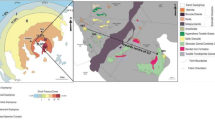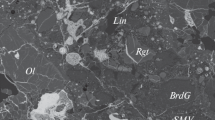Abstract
Clasts of shocked garnet-sillimanite gneisses comprise a minor fraction of the allochthonous breccia at the Haughton impact structure. Refractive indices of the diaplectic and fused components of the gneisses, and reduced specific gravity indicate shock pressures from 35 to 55±5 GPa and effective post-shock temperatures from 500° to 1,000° C in a suite of selected samples.
Sillimanites remain birefringent but display several effects of shock metamorphism. Shock-produced planar features and planar fractures are highly developed; optic axial angle (2V y ) increases from near normal (26°) to over 80° within a sample; there is a reduction in optical relief and a development of a pale brown colouring which generally deepens in shade as shock level increases. There is no unambiguous evidence, optically or from X-ray investigation, of a high-pressure Al2SiO5 polymorph or breakdown to mullite and silica. The highly shocked sillimanites have anomalous K2O contents from 0.11% to 0.92%. Potassium appears to substitute for aluminum and, to a lesser degree, for iron while retaining sillimanite stoichiometry, and the amount of substitution generally reflects increased shock level. The source of the contributed potassium is the coexisting shock-fused feldspar glass. The glass of each sample is derived primarily from melted alkali feldspar with a minor and varied admixture from the breakdown of mafic minerals. The glasses are depleted in K2O, although Na2O is unaffected, and the extent of depletion can be correlated with the increased K2O content of the associated sillimanite. The incorporation of potassium in shocked sillimanites is a function of both degree of shock deformation and availability of potassium from other coexisting shocked phases. It is speculated that the brown colouration is a function of ferrous iron content and may reflect post-crater thermal history rather than shock level.
Similar content being viewed by others
References
Ahrens TJ, Anderson DL, Ringwood AE (1969) Equations of state and crystal structure of high-pressure phases of shocked silicates and oxides. Rev Geophys 7:667–707
Ahrens TJ, O'Keefe JD (1972) Shock melting and vaporization of lunar rocks and minerals. The Moon 4:214–249
Albee AL, Chodos AA (1969) Minor element content of coexistent Al2SiO5 polymorphs. Am J Sci 267:310–316
Bell PM, Mao HK (1972) Crystal-field effects of iron and titanium in selected grains of Apollo 12, 14 and 15 rocks, glasses, and fine fractions. Proc Lunar Sci Conf 3rd: 545–553
Chinner GA, Smith JV, Knowles CR (1969) Transition-metal contents of Al2SiO5 polymorphs. Am J Sci 267A:96–113
Deer WA, Howie RA, Zussman J (1962) Rock-forming minerals l, Ortho and ring silicates. Longmans Green and Co Ltd, London, p 333
Dence MR, Engelhardt W von, Plant AG, Walters LS (1974) Indications of fluid immiscibility in glass from West Clearwater Lake impact crater, Quebec, Canada. Contrib Mineral Petrol 46:81–97
Frisch T, Thorsteinsson R (1978) Haughton astrobleme: a Mid-Cenozoic impact crater, Devon Island, Canadian Arctic Archipelago. Arctic 31:108–124
Grieve RAF, (1978) Melt rocks at Brent crater, Ontario, Canada. Proc Lunar Planet Sci Conf 9th pp 2579–2608
Haggerty SE, Lindsley DH (1970) Stability of the pseudobrookite (Fe2TiO5) — ferropseudobrookite (FeTi2O5) series. Carnegie Inst Washington Yearb 68:247–249
Plant AG, Lachance GR (1973) Quantitative electron microprobe analysis using an energy dispersive spectrometer. Proc 8th Nat Conf Electron Microprobe Analysis (New Orleans): Paper 13
Raikes SA, Ahrens TJ (1979) Post-shock temperatures in minerals. Geophys J Roy Astron Soc: 717–748
Robertson PB, Grieve RAF (1978) The Haughton impact structure. Meteoritics 13:615–619
Schneider H, Hornemann U (1975) Disproportionation of andalusite (Al2SiO5) into A12O3 and SiO2 at very high dynamic pressures. Naturwiss 62:296
Stöffler D (1970) Shock deformation of sillimanite from the Ries crater, Germany. Earth Planet Sci Lett 10:115–120
Stöffler D (1971a) Coesite and stishovite in shocked crystalline rocks. J Geophys Res 76:5475–5488
Stöffler D (1971b) Progressive metamorphism and classification of shocked and brecciated crystalline rocks at impact craters. J Geophys Res 76:5541–5551
Stöffler D (1972) Deformation and transformation of rock-forming minerals by natural and experimental shock processes: I. Behavior of minerals under shock compression. Fortschr Mineral 49:50–113
Stöffler D (1974) Deformation and transformation of rock-forming minerals by natural and experimental shock processes: II. Physical properties of shocked minerals. Fortschr Mineral 51:256–289
Author information
Authors and Affiliations
Additional information
Contribution from the Earth Physics Branch No. 951
Rights and permissions
About this article
Cite this article
Robertson, P.B., Plant, A.G. Shock metamorphism in sillimanite from the Haughton impact structure, Devon Island, Canada. Contr. Mineral. and Petrol. 78, 12–20 (1981). https://doi.org/10.1007/BF00371139
Accepted:
Issue Date:
DOI: https://doi.org/10.1007/BF00371139




